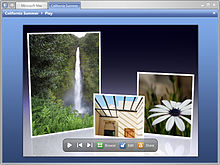- Microsoft Max
-
Microsoft Max was the codename for a prototype software application developed by Microsoft. It is an application for creating virtual photograph albums and distributing them online in a peer-to-peer fashion. Features of the Max technology demo included the ability to annotate photos and arrange them in custom layouts, slideshows and a "3D Mantle View".
The longer-term goal of Max was to facilitate peer-to-peer communications of many kinds of files, not just photos. On November 1, 2006, Microsoft announced that the Max project was being discontinued, but hinted that some of the functionality may be integrated into other Windows Live applications or services in the future.
The product was named Max after a dog belonging to Deana Fuller, one of the project team members.[1]
In a news posting at LiveSide, it was reported that Microsoft Max was a preview of a larger project codenamed Project M, which is to be a graphical front end to sharing of all kinds of files, not just pictures, as well as storage and management of the shared files. Built using WPF, it can be used manage data from various data sources including web, file system, portable devices, e-mail stores as well as share data between disparate data sources. However, it was not made clear whether the project, which was being pursued as a part of Windows Live initiative would reach the market.[2]
Requirements
Max requires .NET Framework 3.0 RC1, and can only be installed on Windows XP with Service Pack 2 and an NTFS hard disk partition; Windows Vista and Windows Server 2003 are not supported.
References
- ^ http://blogs.msdn.com/b/dancre/archive/2005/10/10/479184.aspx
- ^ Kip Kniskern. "Windows Live Storage: Live Drive, Sky Drive, SDrive, Project M?". LiveSide. Archived from the original on 2007-06-01. http://web.archive.org/web/20070601190129/http://www.liveside.net/blogs/main/archive/2006/07/11/Windows-Live-Storage_3A00_-Live-Drive_2C00_-Sky-Drive_2C00_-SDrive_2C00_-Project-M_3F00_.aspx. Retrieved 2007-06-27.
External links
Categories:- Discontinued Microsoft software
Wikimedia Foundation. 2010.

